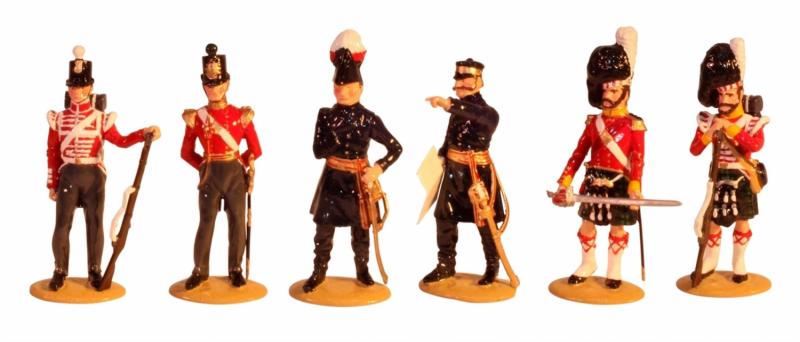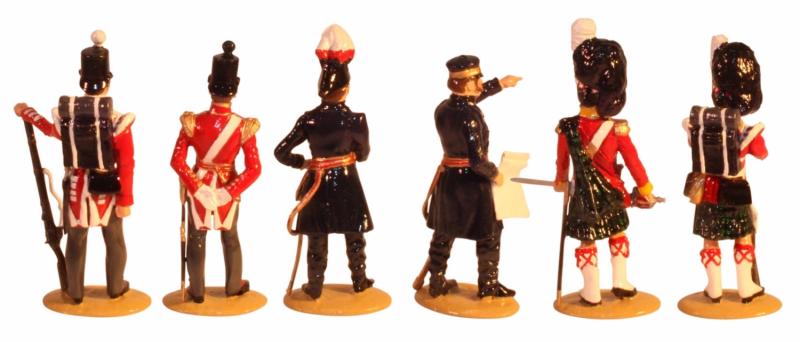Christmas Set 2019: The British Army, The Crimean War, 1854--6 figures
$165.00
Out of Stock
Item Number: CHRISTMAS2019
This 6-figure set comprises an officer and private of both the 93rd Highlanders and the 33rd Regiment of Foot, together with the British commander, Lord Raglan, and an officer of his staff. Though resplendent in British scarlet and blue, this small vignette represents a decisive moment on the army’s long road to modernity.
165 years ago, the British Army found itself in the most unlikely of alliances with their age-old adversaries, the French. The two nations had despatched a joint expeditionary force to the Balkans in support of the Turks, with the aim of curbing Russian expansion into the fragmenting Ottoman Empire. Having embarked with grand ambitions, the Allies arrived in Bulgaria in June 1854 only to find the Russian forces withdrawing before they could be brought to battle. Under pressure from a vocal populous back home, and with need to justify the expense of the expedition, the Allies agreed to mount a punitive attack on the Russian Black Sea naval base at Sevastopol, and so set sail for the Crimea.
The resulting campaign would prove a wake-up call for a British Army that had too long rested on the laurels of Waterloo. The Duke of Wellington had died in 1852, and few sought to change a system that had served the nation’s greatest solider well. Despite the greater accuracy of the recently issued rifled muskets, the British infantry continued to fight in formations inherited from the Napoleonic Wars. Tactics and attitudes (and in some cases, officers), were unchanged since 1815, and had their Russian opponents been similarly armed, the outcome might have been very different. It was, in greater part, the discipline and steadfast determination of the British infantry that saw the war successfully concluded, in spite of the systemic failures of their commanders and commissariat.
The stoic determination of the British soldiery is reflected in the composition of this Christmas set, for both regiments depicted were to distinguish themselves in the line of battle.
It was not simply tactics that harked back to past campaigns. The 33rd Regiment of Foot could boast a long association with the late Arthur Wellesley, 1st Duke of Wellington, stretching back to 1793 when he joined as a major by purchase. The regiment served under Wellesley in India, gaining the battle honour of ‘Seringapatham’ in 1799, but their proudest honours would be won at Quatre Bras and Waterloo, under the by then Duke of Wellington. In recognition of their close ties with the late, great commander, Queen Victoria had bestowed upon them the title of 33rd (The Duke of Wellington’s) Regiment in 1853.
It was with the name of a national hero newly embroidered on their regimental colours that the 33rd advanced at the Battle of Alma on the 20th September 1854. Dug in on the heights overlooking the river, Russian forces barred the Allies’ advance on Sevastopol, with the formidable Greater Redoubt as the key to the defences. Placed at the centre of the 1st Brigade of the Light Division, the 33rd advanced straight up the slopes into the waiting Russian guns, but an error in deployment caused the lines of the Light Division to merge and muddle with those of the neighbouring 2nd Division.
Seeing the confused morass below, the Russian infantry attacked down the slope, but were driven back by the sheer weight of the British rifled volleys, whose Minié bullets out-classed the archaic Russian smoothbores. The British then doggedly fought their way up the ridge, with the 33rd being the first to breach the redoubt’s embrasures. Greatly depleted by the assault, the Light Division could only briefly hold the redoubt, before being driven back down the slope by a Russian counter attack. It took the arrival of the British second wave, composed of Guards and Highlanders, to reinforce the attackers, then drive the defenders from the heights, putting the Russian Army to flight. Victory was achieved with great valour, but at great cost. Of the 2,002 British casualties, the 33rd accounted for 239; the highest of any British unit engaged.
The power of the Minié bullet would be demonstrated once more, when the 93rd (Highland) Regiment of Foot formed up in line at Balaclava, barely one month later. The British had established their supply base in the bay at Balaclava, in order to lay siege to Sevastopol. Both sides were aware of the weakness of this arrangement, as the base lay outside of the main perimeter of the Allies’ lines, and required separate defences of its own. The Russians were quick to take advantage of this error, and launched an attack in force on 25th October 1854, with the aim of destroying the British supply lines and crippling the siege.
The Russian infantry began by attacking the screen of earthen redoubts that formed the harbour’s first line of defence. These redoubts had been built too far forward, so could not be effectively supported from the rear, and without reinforcement their Ottoman defenders were soon driven back. A force of 4,000-6,000 Russian cavalry was then able to pass through the line of captured redoubts, and the Allies scrambled their own cavalry to resist an attack on the harbour itself.
The Russian cavalry commander, Lieutenant Genral Ryzhov, now chose to split his forces. With the imposing masses of British Light Brigade to his right, and the Heavy Brigade to his front, the most direct route to Balaclava lay to his left. Sparsely defended by a screen of British and Turkish infantry, a Russian victory appeared a foregone conclusion. Ryzhov launched the 12th Ingermanland Hussars, over 400 strong, to sweep away this fragile line of men. The already shaken Turkish infantry fired a volley, then fled, leaving only 93rd (Highland) Regiment in the Russian’s path.
The 93rd formed up in line, two deep, with nothing but Balaclava and the Black Sea at their backs. The action was witnessed by the war correspondent for The Times, William Howard Russell, and it was Russell’s description of the Highlanders that would ripple down the centuries. From his vantage point alongside Lord Raglan on the Sapouné Heights, the journalist had a clear view of what followed:
‘The Russians dash at the Highlanders. The ground flies beneath their horses’ feet: gathering speed at every stride, they dash on towards that thin red streak topped with a line of steel’.
But it wasn’t the steel bayonets that stopped the cavalry. Sir Colin Campbell commanded the 93rd, and had seen the effect of their Minié rifles at Alma, so chose to deploy his men in firing line, rather than receive cavalry in square as the British had at Waterloo. This meant every one of the regiment’s 500 rifles could be brought to bear, and they were sighted out to 1,000 yards.
Surprisingly, for an action so famous, accounts vary as to the number and range of the ensuing volleys. The first may have been at the extreme range of 800 yards, and seemed to have little effect. A second, at perhaps less than 500 yards, took a heavier toll and caused the hussars to wheel away to their left. Seeing the cavalry appearing to prepare to outflank him, Campbell calmly wheeled his right rank company round to deliver a final volley. That third decided the matter. The Russian cavalry retreated, and Balaclava was saved.
The phrasing of Russell’s Balaclava despatch was gradually condensed, and by the time the artist Robert Gibb unveiled his iconic oil painting of the 93rd’s triumph in 1881, its title of ‘The Thin Red Line’ had already entered the national lexicon.
The Russian reverse at Balaclava was consolidated when the British Heavy Brigade charged into the remaining body of Russian horsemen and put them to flight. That day would have gone down in military history as a resounding success, had not the Light Brigade then mistakenly ridden to their infamous destruction in the ‘Valley of Death’.

